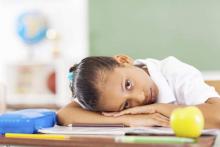SAN DIEGO – With all the media attention drawn to the impact of sports-related concussion in recent years, a significant portion of schools in the United States have adopted “return to play” guidelines, but only a minority have “return to learn” protocols in place, according to Dr. Kelsey Logan.
Literature on the topic is scarce, but one survey of school nurses in Illinois found that 57% of schools in that state had return to play protocols while only 30% had protocols in place for returning to the classroom, Dr. Logan said at the annual meeting of the American Academy of Pediatrics. A separate survey of youth in Nebraska who sustained a concussion in sports found that only 42% of their teachers provided extra assistance in the classroom following their injury.
Limiting cognitive activities “is a big part of their stress in getting over their injury,” said Dr. Logan, who directs the division of sports medicine at Cincinnati Children’s Hospital Medical Center. “I talk to the families about decreasing their child’s emotional stress, and academics are largely a cause of this. They’re stressed from day 1 about the work they’re missing. They’ll say things like, ‘How do I make teachers understand? I don’t want people to think I’m not doing my work.’ If we address those upfront, they tend to be a little less stressed.”
She noted that increasing cognitive activity soon after a concussive injury “worsens symptoms and prolongs recovery. That often takes several conversations with patients and parents before they understand that concept. Many times parents want you to micromanage their kid’s day – tell them exactly what they can and can’t do. That’s not really our role. I cannot predict whether 15 versus 20 minutes of looking on a computer is going to make their symptoms worse. Understanding concepts is important. When you start to experience a big gap in energy and your symptoms get worse, you need to back off. Our goal is to determine the appropriate balance of cognitive activity and cognitive rest.”
Developing a return to learning plan following a concussion starts with an assessment of the patient’s symptoms, which vary from individual to individual. “You can’t predict exactly what a person’s going to go through,” said Dr. Logan, one of the authors of a guideline on return to learning that was published online in Pediatrics (2013 [doi:10.1542/peds.2013-2867]). “Some of it’s trial and error. It’s important to consider physical, cognitive, emotional, and sleep symptoms. All of these can combine. Some patients will have many emotional symptoms after a concussion; others won’t. This is why it’s so important for primary care pediatricians to be treating concussions because they know their patients.”
She recommends that patients and their families use checklists to document symptoms, track their severity and progression, and target symptoms to address with school personnel. The ideal role of family members and friends is to enforce rest and reduce stimulation, while the role of medical team is to evaluate symptoms, prescribe physical and cognitive rest, and get input from family members and school personnel on the patient’s progress. The chief goal is to help the patient get the most out of his or her school day without worsening symptoms. This starts by limiting school time. “For an athlete who has a constant headache, I would recommend that she stay out of school until she feels a little bit better,” Dr. Logan said. “There’s not a specific symptom score that she needs to meet to go back to school. It’s when the family and the patient feel that she can go to school and concentrate. You don’t want to throw that athlete back into a full school day right away. You want to start with a few hours of school, maybe a half-day depending on symptoms.” (The CDC has developed a tip sheet for school personnel on helping students return to school after a concussion.)
Acutely concussed athletes can only concentrate for 30- to 45-minute blocks of time, she added, so “I like to prescribe rest breaks. I try to get them to recognize that if they go to a hard class like calculus and have to work hard for 45 minutes or so they’re probably going to be fried for the next period, so there needs to be something a little less onerous like study hall, or lunch, where they can rest. They need to use common sense during the day.”


